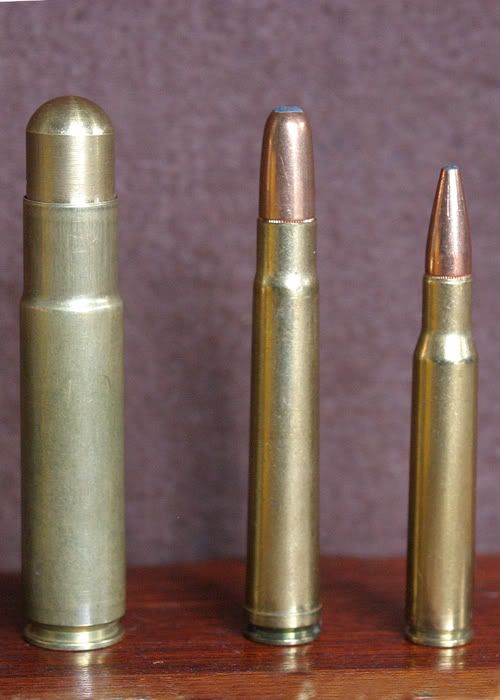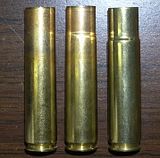03 August 2006, 01:12
BiggestGunIntroducing the 606 Mammoth
I wanted to wai [URL=
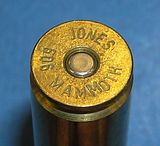
]Headstamp[/URL]
Mammoth Rifle #1 t till I actually saw the article in AH before mentioning it here and I have also been slow to learn how to post pictures. There has already been some discussion about it, which contains some errors. All specs are included in the text of the article. The main points are:
Bullet diameter: .599†[URL=
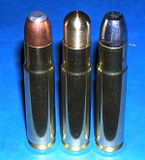
]Barnes solid- Hawk SP- Lead[/URL]
Bullet weight: 850 grs
Max Velocity: 2500 fps
Normal hunting load: 2100 fps
Practice loads (lead bullet): 1500-1700fps
Action: Remington 720
This cartridge came about because A Square couldn’t deliver 577 T Rex brass. For two years Art promised brass but it was looking like he could never deliver. If I was going to have custom brass made anyways then it might as well be a wildcat. Naturally right after my brass was delivered the new folks at A Square called to say their brass was ready.
Here behind the golden curtain of California all existing 600 caliber rifles and cartridges are considered a destructive devise so are illegal. This makes the 606 Mammoth the biggest gun (by bore diameter at least) available here.
Prototype 606 cartridges would feed just fine in my T Rex rifle but it was obvious that this would be the max case diameter that will work. Thinking there may someday be some call to rebarrel T Rex guns the rim diameter of the 606 was made the same as the 577 T Rex (.688), so the 606 is just slightly rebated.
Another justification for the project was that there aren’t a lot of bullets available for the big guns over .50 cal so custom bullets wouldn’t be out of the question.
Prototype bullets were .620†Barnes solids turned down to .599â€. These shoot well and are expected to penetrate like crazy but have one disadvantage. The fouling is in biblical proportions. Many hours have been spent decoppering this beast and all products on the market have been tried. So far the best has been JB bore paste on a 20ga tornado coil brush. Then Barnes CR-10 and finally Outers Foul Out electronic cleaner. The new Hawk bullets don’t foul much at all and even my hard cast lead is easy enough to keep clean.
The case is based on the 600 nitro as stated in the article and having the smaller diameter bullet allows for a nice shoulder to headspace on, eliminating the need for a bulky and archaic belt.
The Remington 720 is a controlled feed type action. Normally one wouldn’t chop up such a rare collectors piece but I actually found a beater gun to use. For those not familiar with these actions, it is the most modern of the 1917 family. They are controlled feed, long, strong and a little more exotic than the usual CZ 550.
We will be building these in my shop on customer supplied actions and have orders for a couple already.
I was somewhat concerned about taking this gun out of the country after the discussions on this board about the legality of exporting the big bores but not enough to leave it home. I can’t see having an African rifle that hasn’t been there, or at least planning to go.
There were no problems in my travel except for one particular customs official in Sacramento who would not sign a 4457 for anything over 50 cal. Other offices weren’t concerned.
On my hunt it was great to have my rifle along even though the right buffalo was not located. It was very fun to watch the staff shoot the Mammoth. I particularly wanted to see the game scout get smashed, as he was less than scholarly during the hunt. Unfortunately he didn’t get knocked down or even drop the rifle but it sure brought a grimace to his face and a hoot from the rest of the guys- they all had to try then.
Our PH was Jonathan Taylor, which is agreed by all who have hunted with him, to be a first class hunter and genuinely nice guy, put my partner on two good buffalo and one super nice leopard. I have hunted with Jonathan before and he is a master at handling tough animals as well as tough clients.
The Mammoth will be heading back to Africa next year for elephant. It is one of the communal permit hunts in northern Namibia f
600 OK-606-600 Nitro or a non-trophy bull. I am already counting the days [URL=
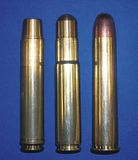
]600 OK- 606- 600 Nitro[/URL]
04 August 2006, 00:23
BiggestGunIt appears that many of you don't subscribe to African Hunter. If not then you should. Here is the article:
606 Mammoth- Quest for the “Biggest Gunâ€
As an African big bore rifle enthusiast I was always looking for the next
and bigger gun to build. After the 577 T Rex the choices get real limited.
The next step up is the 600 Nitro and a small handful of wildcats based on
it. Unfortunately these use a .620 diameter bullet and exceed California’s
.600†limit. Here in the golden state, the 577 cartridges, which use a .585
diameter bullet, are the largest we can legally own. Not that the 577 is
underpowered, it’s awesome, just that it leaves .015†in bullet size left
unharnessed. With these parameters the new size of .599 was conceived.
With only one year before my next hunt in Tanzania it would be pushing it to
have a working model in time but decided to try
GMDR’s computer cartridge designer was handy playing with design. . The
brass diameter was made the same as the 600 nitro with the hope it might
make it easier getting custom brass built. It is also the max diameter that
can be stuffed into most actions. I wanted a nice big cartridge but not
excessive case capacity. Prototype cases were made by reforming 600 Nitro’
s and turning the rims down. This left a web too weak to fire, but allowed
me to experiment with the large cartridge and determine the practicality of
chambering in my action. I settled on a 25-degree shoulder for headspacing.
No belt is needed to interfere with feeding. The rim is slightly rebated to
match the 577 T Rex cartridge and most bolt diameters.
It is well known that larger case capacity will lower operating pressure. It
also can increase recoil due to the necessity of burning of more powder. The
difference in recoil is usually barely noticeable when comparing cartridges
like 300 Win Mag to 300 WSM but is easily noticed when the cartridge
produces recoil this extreme. Smaller cases, in this case the same size as
the 600 Nitro case, but with thicker sidewalls, loaded with higher
pressures, produce less recoil. This is the thinking behind the modern
short magnum cartridges, though they operate at vastly higher pressures.
Fired 606 cases all but fall out of the chamber until velocity reaches 2300.
Even then they extract easily, something very important on dangerous game
guns.
Dieter Horneber in Germany has a great reputation for quality brass and is
willing to build relatively small batches. After an 8-month wait I had my
1000 pieces of brass.
Pac Nor barrels in Oregon tooled up for the new barrel size. They are known
for their match quality barrels and build some biggies too. A twist of 1 in
18†was chosen.
Dave Manson of Manson reamers made my chamber reamer and headspace gauges in
record time.
As this is primarily an elephant cartridge solid copper bullets were to be
the main projectile. By lathe turning 900-grain Barnes 600 Nitro bullets to
.599â€, nice factory looking 850-grain solids result. As mixed bags are the
norm in Africa it seemed practical to have soft points as well. Many bullet
companies won’t consider small batches of odd bullets but Hawk bullets was
daring enough to tool up for my behemoth and after much work had a nice
looking soft point. Lead bullets are also planned for the future for
cheaper practice.
.
All my African rifles are built on some variation of the 1917 Enfield. Dad
started me sporterizing these at age 14 and I’ve been building them ever
since. They are strong and most importantly long enough for just about any
cartridge- with some work. Mammoth rifle #1 is built on a Remington 720
action. This is the pinnacle of the Enfields and conveniently has a straight
bolt handle. I have grown to accept the unconventional dog-leg bolt handle
of this family of actions but with the recoil of this cartridge the need for
a straightened handle becomes painfully obvious.
One of the prerequisites for design was to fit on a variety of actions and
not require something inordinately expensive. Any of the 1917/P14 actions,
CZ 550 series, Brno 602, or Olympic Arms Ultra Mag could be used. Of course
one of the CNC machined Magnum Mauser actions now on the market would be
ideal if you don’t mind the $2500 price tag.
An English style, high comb stock of my design was built in my shop. It is
extra wide through the grip and forend to give plenty of purchase. The butt
is also maximum size for the largest size Pachmayr Decelerator pad to
spread out the recoil. These pads are very soft but not sticky so let the
stock slide nicely up to the shoulder. This stock design has served me well
on several big rifles. It has dual cross bolts, barrel mounted recoil lug,
full length Devcon bedding and gaps in the right places to prevent splitting
as any extra heavy recoiling rifle will need. My rifle weighs in at 13 lbs
loaded and has a short 21†barrel for handiness in the thick brush. Mercury
tubes are a good recoil absorbing option if one doesn’t mind adding weight.
None were used on this gun though there is room for one in the forend and up
to four in the butt.
I thank two of the gunsmiths working in my shop for their contributions to
this project. Gary Pickel masterfully fit the barrel and tuned the action
like always but is a real genius at making rifles feed. He needed all his
talents to perfect this one. It comfortably holds three rounds in the mag
and feeds flawlessly. Steve Jesse did the stock work. His fitting is
superb and he knows how to make beautiful and strong stocks. I did my own
wood finishing, more to see if I remembered how than of necessity. Managing
a busy shop keeps me away from the workbench. The stock is finished in a
traditional hand rubbed oil finish and the metal a practical soft matte
blue.
My friend custom gun maker Virgil Barcus built the beautiful barrel band
sling swivel and front sight as there are no commercial units to fit this
water pipe sized barrel. Virgil has built hinged floorplates for me in the
past, something almost non-existent for the lowly Enfields. This time a
nice drop-mag unit from Precision tooling was used to gain some extra room.
Sorry they don’t make these any more.
A sister gun was barreled for velocity testing. This is fired from the
Lead Sled shooting platform. I can report that this is a wonderful device
for such a rifle. Using bags of shot to hold it down it tames the recoil
while still letting the shooter get behind the gun.
Loading was achieved by sizing fired cases with a simple neck sizer made up
in the shop. The pressure is low enough that all cases go right back in the
gun with ease. The hardest part is forming the neck on the new brass to
load initially. My 505 Gibbs sizer die will form the neck and was used
initially. Later we chamber reamed a piece of barrel to make a case forming
die.
Initial testing was with the Barnes bullets as the Hawk’s weren’t quite
ready and my hunt was approaching.
H4831 was tested first with loads for the 600 Nitro from the A Square
manual. That limited me to 2000 fps with a full case and compressed load.
Then I tried the faster Reloader 15, which allowed up to 2500fps. Faster is
a possibility but no human would want to fire it. Anything over 2400 is
downright scary to fire even from the lead sled. My target velocity was
between 2000 and 2100 fps-just enough to beat the old 600 Nitro’s 1900fps,
as if that wasn’t already enough. There was a noticeable difference in
recoil between the two powders, the Reloader 15 achieving faster velocity
with less kick for equal velocity. Standard deviation became much closer as
the velocity exceeded 1900 fps and I could start to feel the “crack†at 2000
fps-like black powder rifles but with considerably more gusto, excluding my
4 bore.
I settled on a load of 130 grains giving me 2100 fps to hunt with. While
regulating the sights all firing was done off hand or standing with shooting
sticks. Groups of 3†were usual with two or three often touching, with a
clean barrel. If I let the copper build up too much then groups expanded
drastically. As is common with big bores, loads varying by as much as 300
fps all shot into the same 50-yard group.
This velocity makes it possible for me to fire half a dozen rounds with no
soreness or headache. I get the common big bore headache with any more than
10 rounds through my 505 Gibbs or 20 rounds of 458 Lott. To be honest the
recoil is substantial but not unmanageable for a motivated and experienced
big bore shooter shooter.
During the last three months before my hunt around 200 rounds were fired.
Though each shot is an exercise in trigger control, rapid firing at
simulated charging buffalo was pure fun. Firing and working the bolt from
the shoulder for three quick shots does result in a banged up knuckle from
the triggerguard as I don’t get as firm a grip as usual. Checkering will
help that and also the propensity of the forend slipping out of my other
hand on recoil.
Shooting big bore rifles does come at the cost of stressing ones body. In
preparation for my last Safari I fired 400 rounds of 505 Gibbs, with 200 of
them off the bench. Just before that hunt my shoulder became sore and
started aching. Later there was numbness in my fingers. Problems with my
trigger finger prompted me to consult a physical therapist friend of mine.
He determined I had a ruptured disk in the neck that was pinching a nerve.
Regular workouts and neck stretching pretty much cured it but he warned me
of shooting the big bores. I had already started my 606 project and was
financially committed so knew there was some risk. The next summer when it
became time to start shooting the beast I proceeded cautiously. The lead
sled was handy and used for all bench work but eventually shoulder firing
was needed. Limiting myself to 6 rounds per day at first I gradually worked
up from there. Then a short drag on a pronghorn antelope and the pinched
nerve became active again. I’m hopping it was mostly from the drag.
Acquiring my own neck stretcher and using it two times a day has helped but
hasn’t eliminated the problem. There is slight numbness in my right index
finger, something that would worry any shooter. I understand this is a
common occurrence from the whiplash of car accidents. I have also learned
that this is especially common with big bore shooters. I hope to stave off
surgery.
This year’s hunt consists of me tagging along with good friend Paul Rother
on his first Safari. He is shooting a 505 and is after a “full bag†in
Tanzania. As cameraman and back up shooter, I doubted I’d be needed for
that. He was looking for Lion, Leopard, Buffalo, Hippo, Crocodile and
numerous plains antelope. Paul isn’t interested in Elephant and that’s
where I come in. The area we will be hunting is not known for lots of
trophy bulls due to the relatively recent civil war that resulted in
widespread poaching of the big tuskers. It takes many years for them to grow
big. Nevertheless it will be great to be walking around Africa with my
Elephant rifle and a tag. Living in California, I’m certainly used to
hunting and not shooting anything. As our Fish & Game department
continuity reminds us it is the experience that matters most.
Hunt time finally came and the 606 and I was ready. As the observer for
this 21-day hunt in Burigi Tanzania I was content to look for an exceptional
buffalo only and not just another representative specimen. Unfortunately a
monster bull didn’t materialize nor did a nice bull elephant. It was still
fun packing the mammoth around in Africa. It was also fun to watch the
trackers and game scout shoot on the last evening of the hunt. In all
fairness what they lack in technique they make up for in daring and brute
strength. No doubt from the tremendous work they do day-to-day finding
trophies for us neophytes.
Shortly after getting home a local wild hog presented itself and became the
first animal to fall to the Mammoth. Using solids with a hollow point
filled with lead make a soft point the results were not dramatic. As I
might expect, it sailed through and the pig showed little reaction,
something I’ve encountered before with my 458 Lott using Barnes X bullets.
Nice hole however and it didn’t go far.
Recently Mountian Molds was discovered and a beautiful looking set of steel
blocks was delivered in only 3 weeks. After building my own sizing die to
make them .5995†these flat nose 850gr linotype bullets are shooting great
at 1700 fps. This load is very comfortable to shoot and 20 rounds can be
easily fired in a session. I’m looking forward to trying this load on hogs
and expect to see more reaction at the slower velocity and flatter nose of
the bullet.
Further experiments planned for this year are adding grooves to the brass
bullets to reduce bearing surface and moly coating, both to hopefully reduce
fouling.
 ]Headstamp[/URL] Mammoth Rifle #1 t till I actually saw the article in AH before mentioning it here and I have also been slow to learn how to post pictures. There has already been some discussion about it, which contains some errors. All specs are included in the text of the article. The main points are:
]Headstamp[/URL] Mammoth Rifle #1 t till I actually saw the article in AH before mentioning it here and I have also been slow to learn how to post pictures. There has already been some discussion about it, which contains some errors. All specs are included in the text of the article. The main points are: ]Barnes solid- Hawk SP- Lead[/URL]
]Barnes solid- Hawk SP- Lead[/URL]  ]600 OK- 606- 600 Nitro[/URL]
]600 OK- 606- 600 Nitro[/URL]